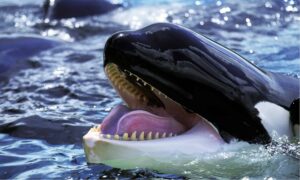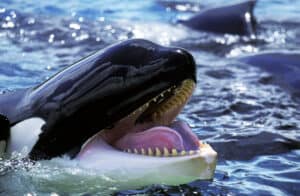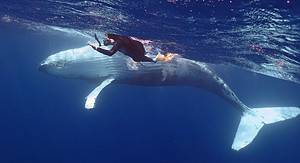If you’ve ever read Moby Dick or had the privilege of seeing whales up close, you’ll have no trouble picturing their awesome majesty. These serene, ponderous mammals have inspired the human imagination for countless generations. Unfortunately, they have also inspired greed and bloodlust in whalers and poachers. With threats to their existence growing daily, we must ask: how many whales are left in the world?
From the blue whale to the humpback whale to the famous orca, discover the towering mythos of these ancient animals!
Types of Whales
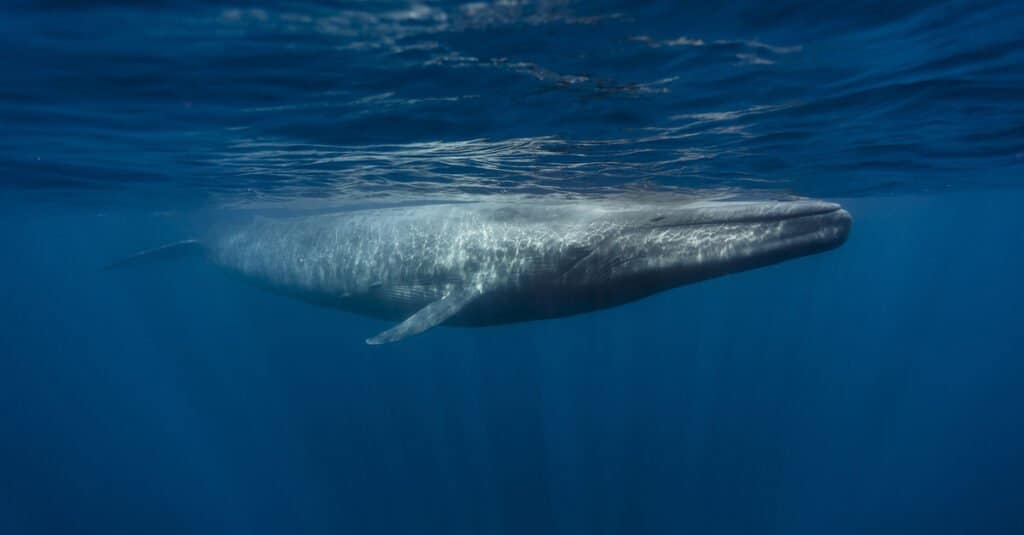
There are over 1.5 million whales worldwide, although some species like the blue whale are endangered.
©Andrew Sutton/Shutterstock.com
Whales, or cetaceans, are divided into 2 categories: baleen whales and toothed whales. As their name suggests, baleen whales (Mysticetes) do not have teeth. Instead, they have baleen, which is a bristle-like substance composed of keratin. This helps them filter krill and other animals from the water.
Toothed whales (Odontocetes) have traditional teeth and can catch larger prey. This category of cetacean includes dolphins and porpoises.
There are 14 baleen whale species, including:
- Blue whales
- Fin whales
- Humpback whales
- Gray whales
- North Atlantic Right whales
There are 72 toothed whale species, including:
- Sperm whales
- Orcas (killer whales, which are technically dolphins)
- Bottlenose dolphins
- Beluga whales
- Harbor porpoises
Baleen whales, also called great whales, are generally much larger and slower than toothed whales. The exception is the fin whale, known as the “greyhound of the sea.” Baleen whales have two blowholes, whereas toothed whales only have one. Dolphins and porpoises are smaller than other whales. Besides being the smallest species of all, porpoises also have flatter teeth.
How Many Whales Are Left in the World?

There are at least 1.5 million whales left in the world.
©iStock.com/MR1805
According to an estimate by the International Whaling Commission, there are at least 1.5 million whales left in the world. This estimate is incomplete, however, as it does not cover all species. It is therefore impossible to know the exact number of whales left.
Certain species are sparser than others. The blue whale has garnered much attention for both its massive size and its endangered status. Approximately 25 000 of these gentle giants remain in the wild today, a huge decrease from the 350 000 individuals roaming the seas 200 years ago. Blue whales can grow up to 100 feet long and weigh over 400 000 pounds.
The North Atlantic Right whale is in even worse shape, listed by the International Union for the Conservation of Nature as Critically Endangered. Fewer than 500 live in the wild today. But worst of all is the Baiji, a species of freshwater dolphin. So few of these exist that some speculate they might already be extinct.
Are Whales Fish?
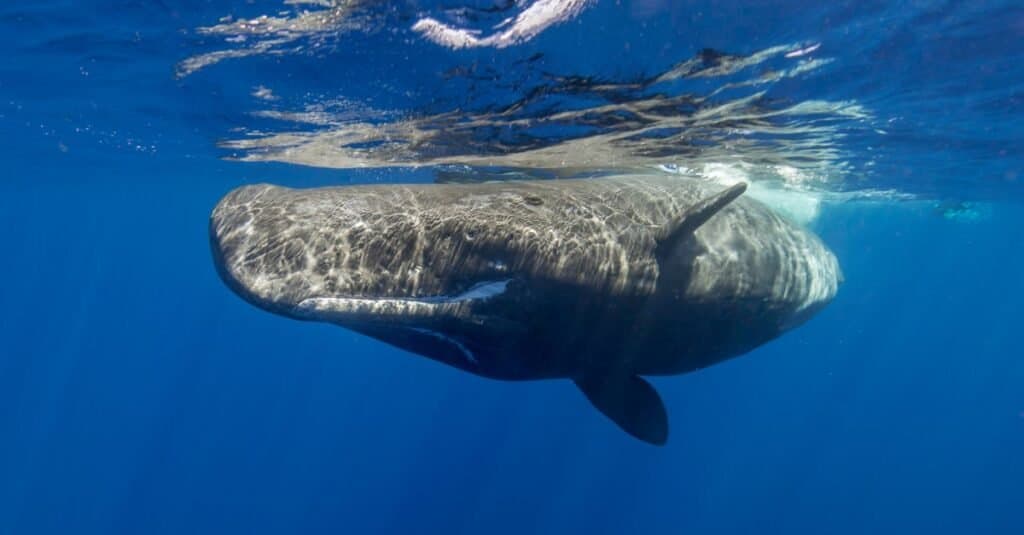
Whales are mammals, which means they are warm-blooded and give birth to live young.
©wildestanimal/Shutterstock.com
Though both live in the ocean and share certain characteristics, whales are not fish. Whales are mammals, which means they are warm-blooded and give birth to live young. They also breathe air with either one or two blowholes depending on their species.
To help them regulate their temperature in cold water, whales are well-equipped with insulating blubber. Whalers hunted right whales almost to extinction because of their extra-thick blubber, a valuable commodity that also kept them afloat after their death. This made it easier for whalers to cut them up and bring them aboard.
Whale Predators
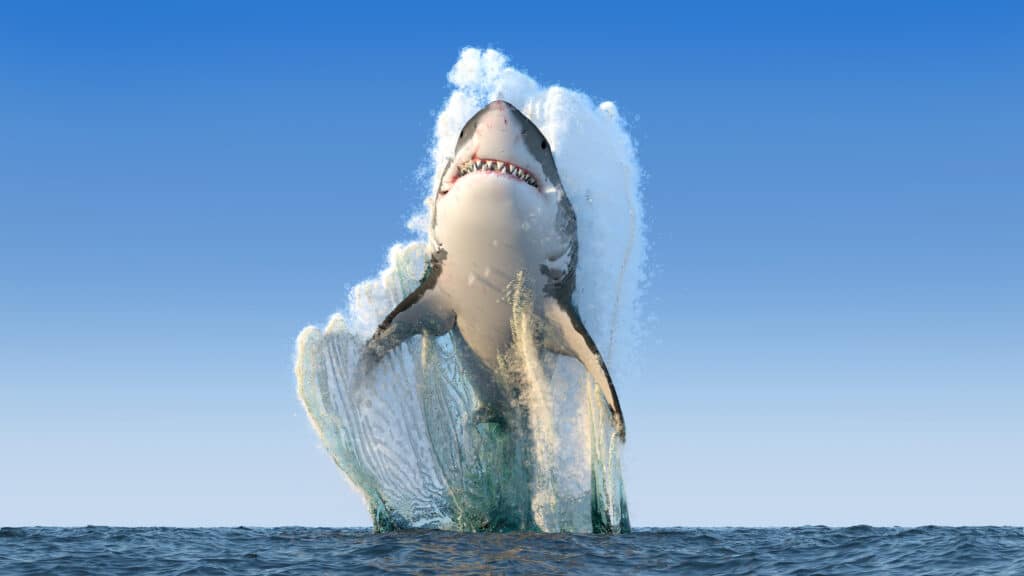
Sharks are the only sea creatures that can effectively attack whales.
©Alexyz3d/Shutterstock.com
Being as large as they are, whales have few natural predators. The only creatures in the sea able to attack them effectively are sharks and orcas. Even then, they prefer to cull baby whales (calves) from their mothers or groups. Calves are much more manageable and put up less of a fight.
Orcas are very social animals and rely heavily on their family group for survival. Therefore, they often hunt in packs. This has earned them the name “the wolves of the ocean.” As apex predators, they have no natural enemies and can hunt at will. Even blue whales, the largest mammals on earth, occasionally suffer attacks by killer whales.
However, orcas and sharks are not the biggest threats to whales. Humans have hunted them almost to extinction and continue to threaten them today despite intense conservation efforts. Indirect sources of trouble, like oil and plastic pollution, also threaten their wellbeing.
Why Do Humans Hunt Whales?
Humans hunt whales for a variety of reasons. First, whales provide a huge quantity of meat, which can be cooked like beef. It is also sometimes used in pet food. However, recent concerns have arisen over the healthfulness of whale meat. Scientists have found environmental contaminants like pesticides and heavy metals in whale blubber. These accumulate as the whales feed on fish and other mammals. Their prey, in turn, have ingested other creatures containing these contaminants.
Whales also provide blubber. This can be cooked to make whale oil, which can be used for soap, edible fats, and as oil for lamps. This practice was much more prevalent a hundred or so years ago, though the Inuit still use it for these purposes. Today, it is more likely to be used along with whale cartilage in health supplements and pharmaceuticals.
Commercial whale hunting has been illegal in most countries since 1986. This includes the use of their body parts to make a profit. However, Japan, Norway, and Iceland object to the international ban. They continue to practice whaling.
Whales in Captivity

Orcas, a type of toothed whale, are often kept in captivity.
©slowmotiongli/Shutterstock.com
If you have ever seen the Free Willy movies, you’ll be aware of the controversy surrounding captive whales. Orcas in particular, such as the movies’ eponymous hero, are the cause of much consternation among conservationists. Being extremely social animals, they require other orcas to live healthy and fulfilled lives.
Captivity severely limits both their space and interactions. Illnesses, depression, stillbirths, and premature deaths are common among captive orca populations. Marine parks draw increasingly heavy criticism for their treatment of animals and their continued determination to put them on display for the public.
The capture of orcas can be particularly heart-rending. They are cornered by commercial whalers who often corral many of them together at once. Frequently, orcas die during the apprehension process. Young orcas are often taken from their mothers much earlier in life than they normally would be. In fact, in the wild, male orcas often remain with their mothers their whole lives.
The transportation process to their new home can be traumatic and dangerous, sometimes resulting in sickness or death. And this is not always the last trip they have to make. Some orcas have been transferred multiple times between facilities, adding unnecessary strain.
Other whales, dolphins, and porpoises also suffer similar fates, confined to restrictive pens and subjected to unnatural conditions. If these majestic animals are to be preserved into the future, conservation efforts must continue.
Up Next:
The photo featured at the top of this post is © iStock.com/kenglye
Thank you for reading! Have some feedback for us? Contact the AZ Animals editorial team.




